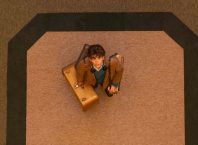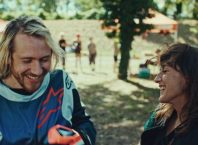Delightfully somber, mysteriously haunting and visually breathtaking, the films of Polish animator Tomasz Bagiński create a deeply evocative cinematic experience. They transport the viewer into a dark and strikingly beautiful fantasy realm, so tangible one becomes engulfed in them as if within a vivid dream. Bagiński lets his work speak volumes, whilst he himself is a rather quiet man of few words. This Wednesday night, Israeli animation-lovers gathered to meet a humble and soft-spoken filmmaker, who presented and discussed his array of acclaimed films.
![baginski6[1]](http://www.midnighteast.com/mag/wp-content/uploads/2011/05/baginski611.jpg)
An eerie tale of a priest’s mysterious and gothic journey, The Cathedral, is an adaptation of a sci-fi novel by Polish author Jacek Dukaj, and visually inspired by Gaudi’s monumental Sagrada Família. This short animated film, created by Bagiński when he was just 23-year-old, won first prize at SIGGRAPH in 2002, and an Academy Award nomination that same year. He likes to call The Cathedral his own “graduation film” – a whimsical remark, considering that this self-taught virtuoso never studied filmmaking or animation academically. The film was his breakthrough into the animation world, but it was his next short, which he considered had truly established him professionally.
Completed in 2004, Fallen Arts was widely successful both commercially and in the festival circuits. Bagiński noted that working on this project provided him with a great appreciation of teamwork in filmmaking, and also deepened his involvement in the Warsaw based Platige Image studio, where he works today as the supervising creative director. The film won a BAFTA award for the short animation film category, a second award at SIGGRAPH, and the Grand Prix at the Golden Horse film festival in 2005.
Fallen Arts, which portrays a dark-humor manipulation of soldiers, is a film that has been given many different interpretations, Bagiński mentioned. Yet, the filmmaker stated he embraces these different views with no reservations: “The author is not the one who should interpret his own film”, he says, “ – the audience should.” Indeed, considering the sophisticated nature of his films, it is not difficult to see how various meanings can be extracted from each of his creations. This very effect produced an interesting discussion over his next piece from 2009.
The Kinematograph, which was selected for the Venice Film Festival, and included in the 2010 Academy Awards short list, is perhaps Bagiński’s most ambitious and personal short film. Interestingly, it is also a film he considers his most academic, tightly edited, and polished piece. Visually impressive, this 3D film features highly stylized characters, and tells the bitter-sweet tale of a 19th century inventor who is obsessed with building a moving-pictures projector. In the discussion that followed the film’s screening, questions from the audience were raised, specifically about portrayal of a Jewish vendor’s character in the story. Bagiński explained that thorough research was conducted in order to reconstruct the European small-town environment and social fabric of that era. His next two films also became very relevant to the prevalent depiction of history in his works.
City of Ruins and Animated History of Poland were both produced in 2010, and are both works of art that exhibit meticulous attention to historical accuracy. City of Ruins is a five-minute film, which was commissioned by the Warsaw Rising Museum, and shows the original flight paths of the British airplanes, which documented the destroyed city of Warsaw in 1945. Animated History of Poland was commissioned by the Polish government to be shown at the Expo 2010 in Shanhai. The film is a ravishing three-dimensional “moving painting”, in which shots of landmark events in Polish history are edited with exquisitely timed and creatively dynamic transitions. These recent works led Bagiński to speak more about avid interest in eclectic projects and his goals as a film director.
Bagiński’s work at Platige Image is extremely versatile. He is a director, animator, producer, and a special effects artist, who has a repertoire raging from short films to commissioned projects and almost one hundred commercials. When asked how is able to balance it all and to have room for his personal work, he humbly replied: “I’m just a guy who likes to work as a film director”, and stated that he enjoys working commercially just as much as he enjoys giving life to his independent short films. He also disclosed his current plans to make a feature length film for his next project.
Tomasz Bagiński loves working as a film director, and it is clear we will soon see many more exciting projects emerge from Platige Image. This recent encounter with Bagiński in Holon gave us the opportunity to have a glimpse behind the scenes, and discuss both the conceptual and technical sides of his work. Filmmaking can be very labor-intensive, he concluded, but also gratifying when it is shared. In filmmaking “the magic”, as Bagiński called it, “belongs to the audience.”
.






Comments are closed.